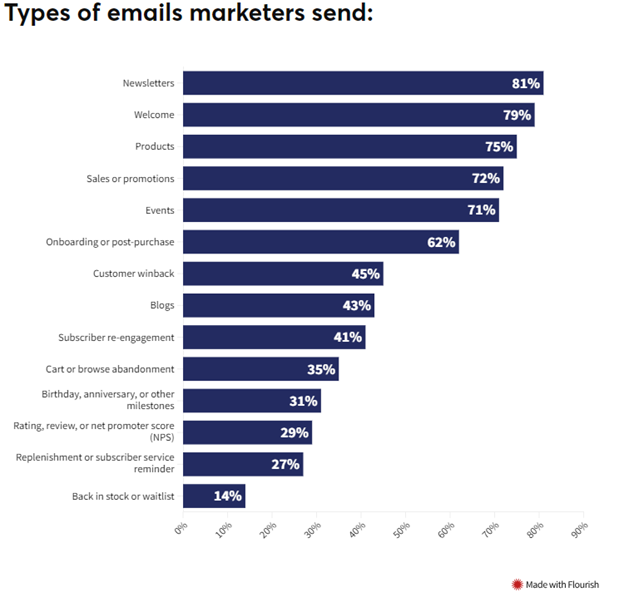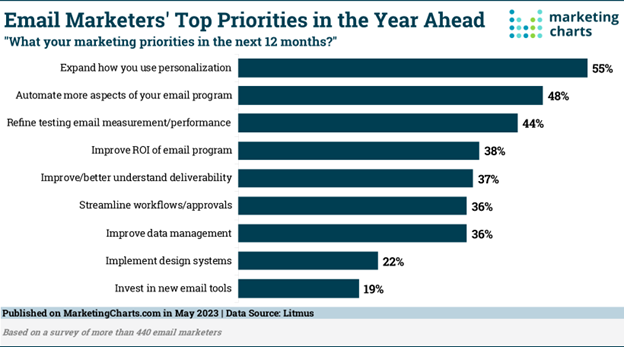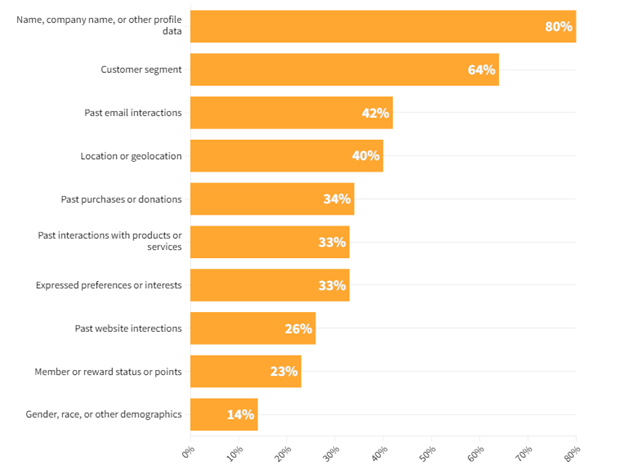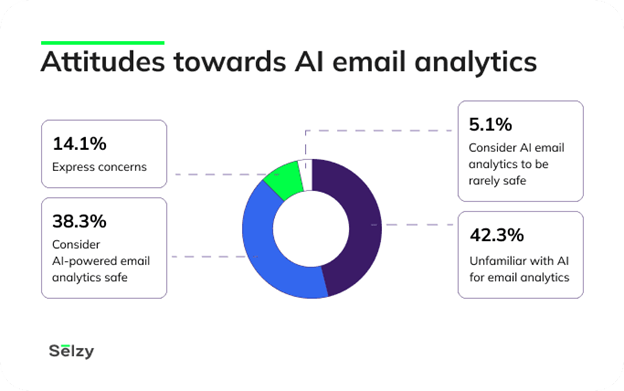Email marketing isn’t just about sending messages to inboxes anymore; it’s a dynamic ecosystem where innovation, personalization, and data-driven decision-making converge to create powerful results.
Whether you’re a seasoned email marketer or just getting started, these 100+ stats will provide valuable insights, trends, and benchmarks that can guide your campaigns to success in the ever-evolving digital landscape.
So let’s up your email marketing game, dive into the numbers, and discover how this tried-and-true channel is transforming into an even more potent tool for businesses and marketers alike.
Table of Contents
- Editor Picks
- General Email Overview
- Email Strategy
- Email ROI
- Email Personalization
- Email Automation
- AI in Email
- Mobile Email
- B2B Email
- Just For Fun
Top 10 Editor Picks
1. There are over 4.3 billion email users worldwide in 2023—more than half the world’s total population. The number of email users is expected to increase to 4.6 billion by 2025.
Have you heard that email marketing is dead? Well, clearly it is not and provides an excellent and low-cost channel to keep as part of the marketing mix.
2. Segmenting campaigns leads to a revenue increase of up to 760%!
Personalization provides better customer experiences and consumers will reward you with higher engagement and brand loyalty. However, read on – the repercussions of NOT personalizing can be just as detrimental.
3. 52% of consumers say they’ll go somewhere else to find what they’re looking for if an email is not personalized.
This showcases that personalization is no longer an option, but a must-have strategy to stay competitive and engage today’s consumers.
4. According to consumers, the most frustrating things about personalization are: recommending items that don’t match their interests (34%), expired offers (24%), name misspelling (15%), inappropriate season or location offers (14%), already purchased promotions (13%).
Consumers are paying attention and have high expectations when it comes to personalization, being put off by anything from a misspelled name to items that don’t match their interests and more. Spend extra time to ensure your personalization techniques are up to par – and then check again to be sure.
5. Adding videos to your emails can increase open rates by 300%.
Videos continue to gain momentum and can highly impact the success of your email strategies. Videos are also an excellent medium to capture the attention span of younger audiences and shorter attention spans.
6. Welcome emails generate 320% more revenue per email than promotional ones.
Don’t neglect the power of welcome emails to boost engagement and improve the customer experience.
7. 60% of consumers have completed a purchase after receiving a marketing message by email.
Consumers not only will open and read emails, but 6 out of 10 have also completed a purchase from receiving an email communication. If you are still on the fence about the power of email, this stat should speak for itself.
8. 77.5% of business executives use AI to personalize marketing emails.
A massive number of marketers have already adopted and integrated AI into their email martech stack and seeing impressive results, as showcased in our next top stat.
9. Revenue increased by 41%, and CTR increased by 13.44% for marketers who utilize AI for email personalization.
Test out AI in your email marketing to see what resonates and where you may be seeing higher engagement. AI tools are being adopted at rapid speeds so test now before you get left behind.
10. 82% of marketers use automation to create triggered emails which result in 8 times more opens and greater earnings than typical bulk emails.
Marketers clearly believe in the power of automation, with over 8 in 10 using automation. However, even more impressive is the automated email generated eight times more opens than a bulk email campaign.
General Email Overview
The first email was sent by Ray Tomlinson, a computer engineer, in 1971. Ray Tomlinson was working on ARPANET, the precursor to the modern internet when he sent the first email between two machines located side by side. Email has since become one of the most widely used communication methods on the internet.
- 4.3 billion email users worldwide in 2023—more than half the world’s total population. The number of email users is expected to increase to 4.6 billion by 2025.
- Over 91% of Americans use email.
- 35% of consumers in the U.S. have two email addresses and 28% have over four.
- In 2023, an average of 347.3 billion emails are sent and received per day—a 4.3% increase from the previous year, and it’s forecasted to increase further by a similar margin in 2024, hitting 361.6 billion.
- 99% of users check their email every day. Of those email users, 58% of consumers check their email first thing in the morning.
- 40% of users have at least 50 unread emails in their inbox.
- 63% of people said that they open an email to find discounts.
- Consumers spend an average of 10 seconds reading brand emails.
- 1 in every 6 emails is sent in the spam folder.
Email Strategy Statistics
- Types of emails marketers send include:

- Adding videos to your emails can increase open rates by 300%.
- On average, video thumbnails can increase clicks by 22%.
- Welcome emails generate 320% more revenue per email than promotional ones.
- More than 8 out of 10 people will open a welcome email, generating 4x as many opens and 10x as many clicks as other email types.
- Abandonment cart emails have 45% open rates, and 21% of them are clicked on. Plus, half of the users that clicked completed a purchase.
- Including an emoji in your subject line can increase open rates by 45%.
- 45% of users say they open emails based on who they’re from, and 33% open them based on the subject line.
- Emails with graphics have a 1.12% higher click-through rate than emails without any.
- Out of the received emails, consumers are more likely to buy from emails that include a coupon or discount (67%), check-in with consumers (33%), and business updates (28%).
- The three most common actions users take after reading an interesting marketing email are making an online purchase (27.1%), visiting a company’s website (26.2%), and making a purchase at a retail store (21.6%).
- When text in a call-to-action button is changed from second-person viewpoint to first-person viewpoint, clicks improve by 90%.
- When you include a call-to-action button in your emails as opposed to a text link, conversion rates can increase by up to 28%.
- Your audience will reward you with higher open and click rates if you don’t send more than five newsletters a week.
- Nearly 22% of all email campaigns are opened within the first hour of sending.
Email ROI Statistics
- Email generates $36 for every $1 spent, meaning email marketing ROI is 3600%.
- Other stats show that for every $1 you spend on email marketing, you can expect an average return of $40.
- 18% of companies achieve email marketing ROI greater than $70 per $1 invested.
- 60% of consumers have completed a purchase after receiving a marketing message by email.
- When marketed via email, consumers tend to spend 138% more than shoppers that do not receive email offers.
- Only 30% of brands believe that they can measure their email marketing ROIs adequately.
Email Personalization Statistics
- Personalization is a top priority for 55% of email marketers.

- 52% of consumers say they’ll go somewhere else to find what they’re looking for if an email is not personalized.
- 74% of Baby Boomers consider email to be the most personal means of communicating with their brands of choice.
- Personalized emails are opened 82% more than generic emails.
- The top 10 elements used to personalize marketing emails include:

- In another study, 66% of marketers personalize their emails based on subscriber age data.
- Personalized abandoned cart emails work – 60% of shoppers returned to complete their purchase after receiving one.
- Personalized emails can produce six times more transactions than non-personalized emails.
- According to consumers, the most frustrating things about personalization are: recommending items that don’t match their interests (34%), expired offers (24%), name misspelling (15%), inappropriate season or location offer (14%), already purchased promotions (13%).
- Segmenting campaigns leads to a revenue increase of up to 760%!
- Personalization in email messages improves open rates by 29% and click-through rates by 41%.
- Personalized subject lines increase email open rates by 26%. (Campaign Monitor)
- The top three reasons email marketers use personalization are improved open rate (82%), higher CTR (75%), and better customer satisfaction (58%).
- By addressing the recipient by their name, you can increase open rates and CTR up to 35%.
- Personalized emails have 29% higher unique open rates and 41% more unique click rates than non-personalized emails.
- 60% of retail, e-commerce, and consumer goods and services companies are personalizing emails based on past purchases, versus 38% in 2019.
Email Automation Statistics
- Marketing automation software users can benefit from a 451% increase in qualified leads.
- 35% of marketers use marketing automation software for content creation and email outreach services.
- 67% of marketers use automation for drip or nurture campaigns.
- 56% of marketers use automation for segmentation purposes
- 68.5% of marketers believe that automation improved the targeting of messages.
- 82% of marketers use automation to create triggered emails which result in 8 times more opens and greater earnings than typical bulk emails.
- The best tactics for automation are mapping the customer experience (53%) and the use of personalized messages (51%).
- The single message autoresponder email had an astonishing 98% open rate and a 37% click-through rate.
- Automation tools are used for sending all types of emails:
– welcome emails (47%)
– promotional sales emails (46%)
– transactional emails (28%)
– invitations and reminders (27%)
– blog updates (26%)
– upselling emails (23%)
– event-triggered emails based on customer lifecycle (15%), etc.
AI in Email Statistics
- 95% of marketers who use generative AI for email creation rate it “effective”, with 54% rating it “very effective.”
- 43% of marketers who use generative AI say that it’s most helpful for creating emails.
- 38% of marketers who use AI use it to write emails.
- Revenue increased by 41%, and CTR increased by 13.44% for marketers who utilize AI for email personalization.
- 21% of sales professionals who use AI in their role say that it’s most useful for writing messages to prospects. 32% say it’s most useful for re-purposing messages by adapting them to a different audience.
- 77.5% of business executives use AI to personalize marketing emails.
- AI-written email subject lines increase open rates by 5-10%.
- 58% of marketers are confident that AI can improve email newsletters.
- 51% of marketers find AI more effective than traditional non-AI approaches in email marketing
- 38% of marketers consider AI-powered email analytics safe to use.

Mobile Email Statistics
- A majority of email views come from mobile devices (41%), followed by desktop (39%).
- 46% of smartphone users prefer to receive communications from businesses via email.
- Apple iPhone’s native email app has the highest market share, followed by Gmail.
- Nearly 1 in 5 email campaigns is not optimized for mobile devices.
- Launching a mobile-responsive email design can increase unique mobile clicks by 15%.
- 56% of marketers leverage mobile-friendly emails in their email marketing strategy.
- 25% of people who opened an email over their mobile device will view it once again.
- 40% of people aged 18 years or below will always open the email first on their mobile device.
B2B Email Statistics
- 77% of B2B buyers prefer to be contacted over email – more than double any other channel.
- 87% of B2B marketers use email for distributing content.
- 93% of B2B marketers distribute content via email.
- 64% of small businesses use email marketing to reach customers.
- Email marketing is used mostly for lead generation (85%), sales (84%), lead nurturing (78%), and customer retention (74%).
- 40% of B2B marketers say email marketing is a tactic that is critical to their success.
- 31% of B2B marketers stated that the best way to nurture leads is via email newsletters.
- The average email open rate for B2Bs is 15.1%.
- Email marketing (84%) is the most implemented marketing tactic in B2B business, followed by:
– social media & social media advertising (75%)
– blogging & content marketing (69%)
– SEO (60%),
– tradeshows & events (54%)
Fun Email Facts
- The first recorded use of an emoticon in email, 🙂 (a smiling face), was sent by computer scientist Scott Fahlman in 1982.
- The first unsolicited email, which we now refer to as “spam,” was sent in 1978 when Gary Thuerk, a marketer, sent an email promoting a new computer to 393 recipients.
- The largest generator of spam email in the world, Rustock botnet began around 2006 and came to an end in March 2011. The network was sending out 44 billion spam emails daily, close to half of the spam in the world.
- The “@” symbol, now an integral part of email addresses, was chosen by Ray Tomlinson, the inventor of email, to separate the user’s name from the host computer’s name.
- The famous “You’ve got mail!” voice used in AOL’s email service was provided by Elwood Edwards, the husband of an AOL employee.
- The first US President to send an email while in office was President Bill Clinton. Clinton emailed astronaut John Glenn who was on the Space Shuttle in orbit.
- In 2009, more than 10,000 usernames and passwords obtained from a phishing attack were posted online. Bogdan Calin, an internet security specialist, looked at the data, and found the most frequently used passwords at the time:
- 123456
- 123456789
- 111111
- America
- Iloveyou
- In 2000, the Pentagon accidentally included Claire McDonald, a schoolgirl in the United Kingdom on a top-secret email list. It took them four years before they realized they had included her.




